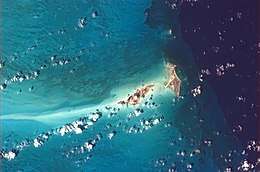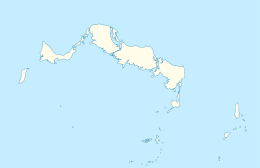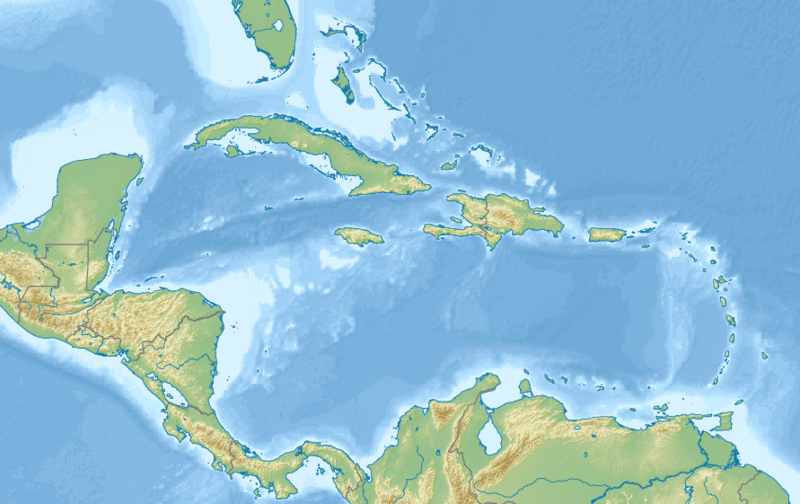Ambergris Cay
Ambergris Cay, also known as Big Ambergris Cay, is a private residential island located within the Turks and Caicos Islands.[1] Not to be confused with Ambergris Caye in Belize, Ambergris Cay is situated to the southeast of the main chain of the Caicos islands. Adjacent to Ambergris Cay is Little Ambergris Cay, which is an uninhabited natural reserve. Little Ambergris Cay is a unique and significant habitat for a wide range of birds and marine life.[2] Ambergris Cay island is approximately four miles (6.4 kilometres) long, one mile (1.6 kilometres) wide, and 1,100 acres (4.5 km2) in total.
 Big and Little Ambergris Cay pictured from the International Space Station | |
 Ambergris Cays The location of Ambergris Cays within the Turks and Caicos Islands  Ambergris Cays Ambergris Cays (Caribbean) | |
| Geography | |
|---|---|
| Location | Atlantic Ocean |
| Coordinates | 21°18′05.27″N 71°37′53.65″W |
| Archipelago | Lucayan Archipelago |
| Administration | |
| British Overseas Territory | Turks and Caicos Islands |
| Additional information | |
| Time zone | |
| • Summer (DST) | |
| ISO code | TC |
The island was named for ambergris, a waxy substance that migrating sperm whales regurgitate and is prized as a fixative for perfume and cosmetic products. Ambergris used to wash up along the 8 miles (13 km) of island's shoreline but is rarely found on the island today.
Ambergris Cay is known for its turquoise and shallow waters. It is surrounded by sandbanks and coral reefs. To the east of the island, the water deepens as part of the Turks Island Passage.[3] Ambergris Cay has been a private island since 1811 and is today managed by Turks and Caicos Collection, a preferred selection of all-inclusive Turks and Caicos resorts.[4]
History
In the late 18th and early 19th centuries, Loyalists settled on Ambergris Cay, raised cows, made pottery, and built houses, stables, and cisterns. The ruins of these early colonial settlements can be seen today on the island. As the island is privately owned and managed, prior permission to visit is required.
John Lightbourne was the island's first owner, having purchased it from the Bahamas administration in 1811.[5][6] Then, Horatio Stubbs of South Caicos purchased the island, the dwelling house, and a female slave in 1826 for the cost of 6,000 bushels of salt.[5] Sisal was raised on the island toward the end of the 1800s.[5]
In 1978 an investment group from the state of Arizona tried to purchase Ambergris Cay, with the goal of building a university on the island. This effort was rejected by the government.[5]
Canadian businessman Henry Mensen bought Ambergris Cay in 1995.[7] Mensen started the development of the island to establish a luxury and exclusive residential community. Through this project, the island today has the Calico Restaurant and Bar (a reference to the famous 17th century pirate), a clubhouse, and robust infrastructure for island's self-sustenance.[7]
Since late 2017, Ambergris Cay is managed by Turks and Caicos Collection.[8] The island boasts 20 private villas, 10 beachfront suites, a spa center water sports center, a marina, the longest private runway in Caribbean capable of accommodating most private airplanes, reverse osmosis water purification, independent electrical generation systems, and a cell tower that provides phone and high-speed internet access.[9]
Transport
Harold Charles International Airport is located on the island. At 5,700 ft (1,700 m), it is the longest privately held airstrip in the Caribbean.[6] The flight time from the main airport in Turks and Caicos Islands, Providenciales International Airport (PLS), to Ambergris Cay is approximately 18 minutes.[10] The size of the airport allows the residents and guests to fly into the island with private airplanes.
Wildlife
Fauna
The reefs are home to dolphins, tarpons, bonefish, turtles, conch, and Caribbean lobster. Reports from local fishermen indicate that green and hawksbill sea turtles nest on the island.[5]
The island is home to the native Turks and Caicos rock iguana (Cyclura carinata), which is critically endangered. The San Diego Zoo has an ongoing research study on the island's fauna.[11] The island also provides habitat for the Silver Key anole (Anolis scriptus), the Caicos least gecko (Sphaerodactylus caicosensis), and the Turks and Caicos curly-tailed lizard (Leiocephalus psammodromus)[12] The Caicos gecko (Aristelliger hechti) occurs on Little Ambergris Cay.[12]
Flora
Endemic to the Turks and Caicos Islands, silverbush (Argythamnia argentea), island heather (Limonium bahamense) and orchid (Encyclia caicensis) are plant species found on Ambergris.[13] Most importantly, the island is a significant habitat for Turk's Head Cacti (Melocactus), the cactus species from which the name of Turks and Caicos Islands derives.[14] The cactus is known for its similarity to the Turkish hat, Fez, and is therefore, called the 'Turk's Head or Cap'.
References
- "Ambergris Cay". Visit Turks and Caicos Islands. Retrieved 2019-04-05.
- "Ambergris Cay". Visit Turks and Caicos Islands. Retrieved 2019-04-05.
- "Turks Island Passage, Turks and Caicos Islands - Geographical Names, map, geographic coordinates". geographic.org. Retrieved 2019-04-05.
- "Know More About Turks & Caicos Beach Resorts". www.turksandcaicoscollection.com. Retrieved 2019-04-05.
- "Ambergris Cays, Turks & Caicos Islands". Turks & Caicos Islands Information Directory. Archived from the original on 24 August 2005.
- "Ambergris Cay". Turks and Caicos Tourism. Retrieved 10 January 2019.
- Tyson, Vivian (20 June 2013). "Ambergris Cay Development Coud Restart Soon". Turks and Caicos Sun. Retrieved 10 January 2019.
- "About Ambergris Cay". Ambergris Cay Turks and Caicos. Retrieved 2019-04-05.
- "About Ambergris Cay". Ambergris Cay Turks and Caicos. Retrieved 2019-04-05.
- "FAQ". Ambergris Cay Turks and Caicos. Retrieved 2019-04-05.
- Pisacane, Corinne (20 October 2014). "Catching Rock Iguanas: Easier Said than Done!". San Diego Zoo. Archived from the original on 22 October 2014.
- Iverson, John B. (1986). "Notes on the Natural History of the Caicos Islands dwarf boa, Tropidophis greenwayi" (PDF). Caribb. J. Sci. 22 (3–4): 192–193. Archived from the original (PDF) on 30 December 2006.
- Williams, Sophie. "The Identification and Conservation of Important Plant Areas: A case study from the Turks and Caicos Islands" (PDF). Interdisciplinary Centre for Conservation Science. p. 23. Retrieved 10 January 2019.
- "Turks and Caicos Islands | Location, People, & History". Encyclopedia Britannica. Retrieved 2019-04-05.